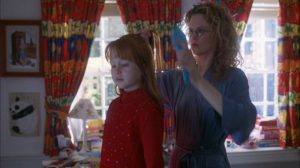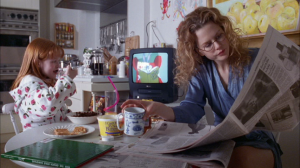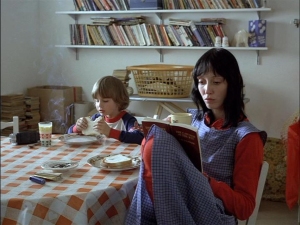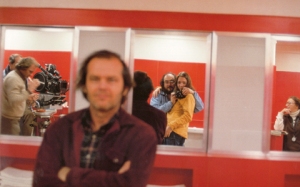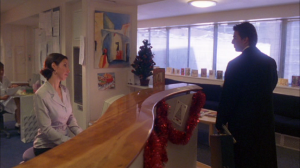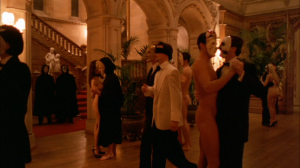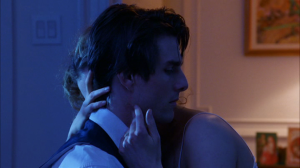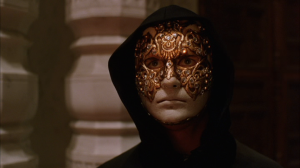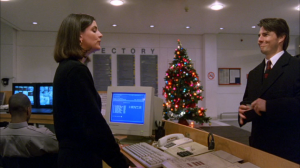Bill is at work. Alice is at home. We cross-cut between the two.
For all that Kubrick pushed the film form forward (alliteration FTW), he certainly wasn’t above sturdy plot-work montages like these; Barry Lyndon and Full Metal Jacket integrate similar scenes within their own pitiless deconstructions of character, setting, and theme. Anyone the least bit familiar with movie drama knows the score. We are witnessing the Harfords, alone, together: physically separated, but united in their adherence to routine. Alice and Helena are sitting at their kitchen table. This is the first glimpse we have of the Harford kitchen; last night was all about fleeing domesticity, if only for a few hours. The kitchen is cozy, the table small and appealingly cluttered. These scenes bring Alice down to earth somewhat, highlighting the bored housewife whose coexistence with glamorous Night Alice (also known as the public face of Nicole Kidman, blurring the line between actor and character) was only implied the night before.
But–and this is fucking crucial to the movie’s success–this disenchantment is not condescending or cruel. Eyes Wide Shut treats Alice like a human being, something you cannot say about most of the myriad suburban-exploitation flicks that cropped up in the late 90s and early 00s. The movie does not view the gap between Alice’s outer serenity and inner turmoil as a lie, or as evidence of weakness or timidity. Rather, it’s a trade-off she’s made, even one that she’s happy with most of the time…but not all the time, and she resents Bill taking her personal and professional sacrifice for granted. It’s worth noting that, unlike the eternally vapid American Beauty (all that which Eyes does right, Beauty does wrong), Eyes Wide Shut doesn’t bother manufacturing a cliched hippie-utopia life for its characters to briefly retreat to before coming to their senses. There is no comfortably circumscribed Other to provide cheap contrast for the Harfords, only the Void: all the security of ego and status and selfhood stripped away, until you are left alone (as in the end of 2001) with your animal self and a mirror. The day-in-the-life-montage provides evidence of the tipping point, as Bill and Alice’s clearly long-cemented routines are contrasted with their uneasy emotional states, riding the candle smoke of last night’s reverie. Alice is feeling resentful, toward her husband and herself. Bill is feeling something stranger, subtler, and scarier: frustrated lust, rattled ego, a fascination with the unfamiliar coupled with a deep-seated dread of the unknown (especially when it comes to sex and death).
So what are they up to? Alice is reading the paper at the kitchen table. Helena takes a bite of cereal, watching Bugs Bunny read aloud: “Not a creature was stirring, not even a mouse.” I bother with this blog because of Kubrick’s peerless ability to create little dense dwarf-star moments like these, begging to be unfurled. We have here a reference to The Shining, in many ways the Kubrick movie most similar to Eyes Wide Shut. The first appearance of Wendy and Danny Torrance in that movie is an almost identical shot: mother and child at a table in a somewhat messy kitchen, mother on the right reading, child on the left eating, cartoon noise blaring in the background. Danny asks his mother if she really wants to spend a winter at the Overlook, using his imaginary (?) friend Tony as a proxy to voice his concerns; Wendy attempts to reassure him, but her pasted-on smile hints at her own desperation and fear. The subtext to this conversation, and every interaction mother and son have throughout the movie, is the deadly terror instilled in them by the patriarchal brute Jack. It’s there in that first scene, in Danny’s chillingly blank expression (he refuses to meet his mother’s gaze, a common sign of child abuse) and in Wendy’s chain-smoking, only the most obvious manifestation of her deeply internalized fear. (The Overlook haunts the Torrances, but uses their psychoses as fodder; similar questions about individual versus systemic responsibility arise throughout Eyes Wide Shut.)
But they can’t talk about it. Wendy and Danny desperately need each other as allies, but their fear and shame keeps them apart and leaves them vulnerable to Jack and his newfound ghost friends. It’s the quiet little subplots that enrich Kubrick’s insect-under-glass worlds, and amidst all the surreal imagery and grandiose camerawork and heady ideas about madness and masculinity and Time Itself, The Shining tells the story of a mother and son learning to trust one another as their world falls apart. The Torrance trio falls apart, but is resurrected as a duo when Danny finds the courage to ditch Tony and warn his mother about REDRUM himself. Perhaps that’s partially why Kubrick shot Jack’s death as a farce–mouth hanging open, eyes upturned, frozen in a state of eternal slapstick. Not only is the monster dead, he’s been thoroughly demystified, and is no longer worthy of a role in his family’s life even as a ghost. That’s the soft-spoken optimism buried deep in The Shining‘s M.C. Escher pattern: that maybe the Overlook is a mausoleum for evil, a sort of metaphysical archive where our bloody past can be imprisoned and the women and children can walk free of the patriarchy. There’s horror in those walls, but at least it’s inside the walls.
Eyes Wide Shut offers no such way out. Alienation, anxiety, abuse, and the Void are constantly with us, infecting every moment, and our most deeply buried impulses and desires are inextricable from the macroscopic systems in which we scurry. This scene is notable not for a failed connection between parent and child, as in that early Shining conversation, but for the lack of any attempt. Alice isn’t reading to Helena, forging a bond in the fires of Christmas; she’s delegated that job to capitalism, allowing Bugs Bunny to serenade her child. (Helena’s desire to watch The Nutcracker the previous night now seems less related to the ritual celebration known as Christmas than to the ritual celebration of consumerism…known as Christmas.)
